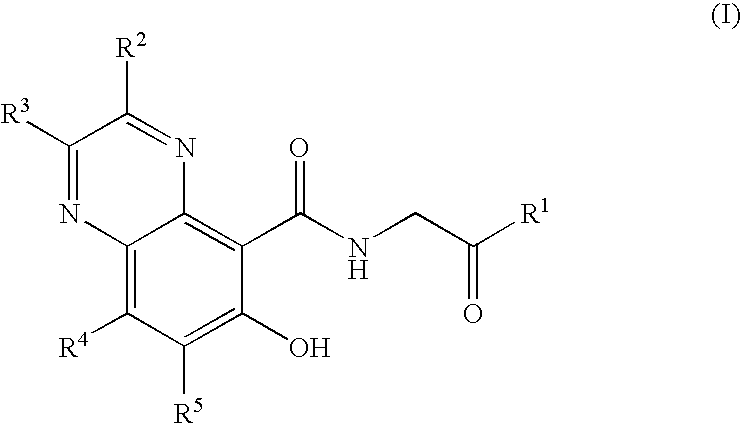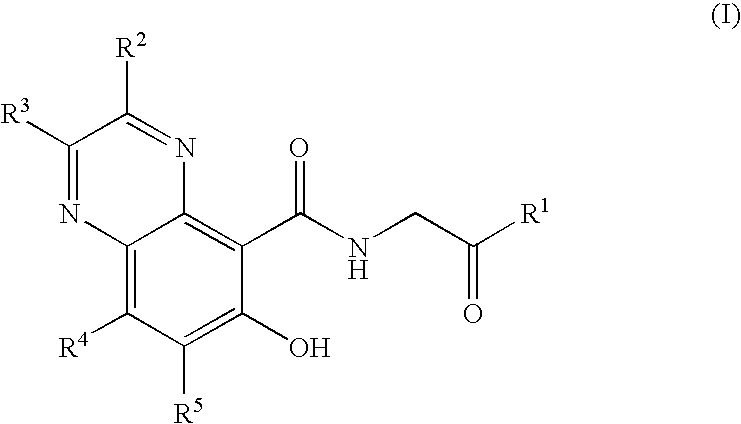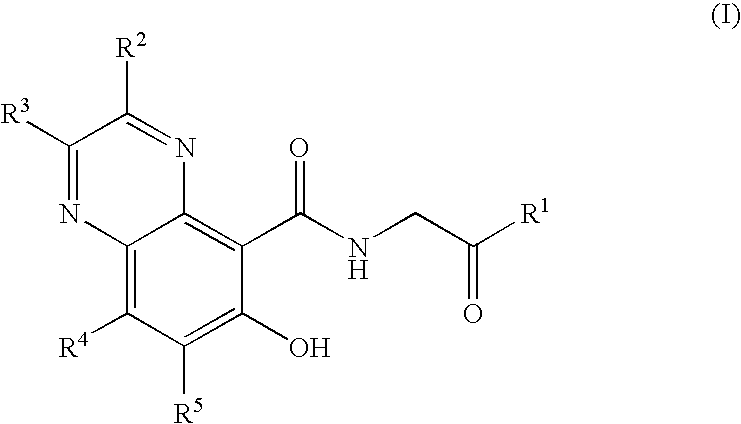Prolyl Hydroxylase Inhibitors
a technology of prolyl hydroxylase and inhibitor, which is applied in the direction of biocide, drug composition, extracellular fluid disorder, etc., can solve the problems of reduced oxygen levels in the blood, ubiquitination of hif-alpha and subsequent degradation, and achieve the effect of increasing the production of erythropoietin and epo
- Summary
- Abstract
- Description
- Claims
- Application Information
AI Technical Summary
Benefits of technology
Problems solved by technology
Method used
Image
Examples
example 1
[0234]
N-[(6-hydroxy-3-phenyl-5-quinoxalinyl)carbonyl]glycine
1a) Methyl 2-amino-6-fluoro-3-nitrobenzoate
[0235]To fuming nitric acid (3.87 mL, 86.6 mmol) at 0° C. was slowly added concentrated sulfuric acid (7.27 mL, 136.4 mmol). After stirring for 5 min., methyl 2,6-difluorobenzoate (3.90 mL, 29.0 mmol) was added and the reaction mixture was allowed to warm to ambient temperature. After 30 min, the reaction mixture was poured into ice-water and extracted thrice with dichloromethane. The combined organic portions were washed with saturated aqueous sodium bicarbonate, dried over MgSO4, filtered, and concentrated in vacuo to afford a colorless oil. MS (ES+) m / e 218 [M+H]+. Upon standing, the oil solidified to a white solid, which was dissolved in ethanol (50.0 mL) and treated with ammonium hydroxide (1.0 mL, 29% aqueous solution) at ambient temperature. After 4 h, additional ammonium hydroxide (0.8 mL, 29% aqueous solution) was added and the reaction mixture was stirred overnight. The s...
example 2
[0242]
N-[(6-hydroxy-3-methyl-5-quinoxalinyl)carbonyl]glycine
2a) Methyl 3-methyl-6-(methyloxy)-5-quinoxalinecarboxylate
[0243]To a solution of the compound from Example 1b) (0.307 g, 1.36 mmol) in ethyl acetate (25.0 mL) was added 10% palladium on charcoal (0.072 g, 0.068 mmol), followed by evacuation of the reaction vessel and purging with nitrogen. The reduction was carried out under 50 psi of hydrogen gas with a Parr Shaker overnight. The reaction mixture was filtered through Celite®, washed through with ethyl acetate, and concentrated in vacuo. A suspension of the resulting yellow oil in water (15.0 mL) and acetonitrile (5.0 mL) was treated with methyl glyoxal (40 wt % solution in water) (0.245 g, 1.36 mmol) and heated to 60° C. for 1 h. Upon cooling, the reaction mixture was diluted with brine and extracted thrice with ethyl acetate. The combined organic layers were dried over MgSO4, filtered, and concentrated in vacuo to afford the title compound (0.273 g, 87%) as an orange soli...
example 3
[0246]
N-[(6-hydroxy-5-quinoxalinyl)carbonyl]glycine
3a) Methyl 6-(methyloxy)-5-quinoxalinecarboxylate
[0247]To a solution of the compound from Example 1b) (0.315 g, 1.40 mmol) in ethyl acetate (20.0 mL) was added 10% palladium on charcoal (0.074 g, 0.070 mmol), followed by evacuation of the reaction vessel and purging with nitrogen. The reduction was carried out under 50 psi of hydrogen gas with a Parr Shaker overnight. The reaction mixture was filtered through Celite®, washed through with ethyl acetate, and concentrated in vacuo. A suspension of the resulting yellow oil in water (10.0 mL) and acetonitrile (2.0 mL) was treated with glyoxal (40 wt % solution in water) (0.200 g, 1.40 mmol) and heated to 60° C. for 1 h. Upon cooling, the reaction mixture was diluted with brine and extracted thrice with ethyl acetate. The combined organic layers were dried over MgSO4, filtered, concentrated in vacuo, and purified via flash column chromatography (40-60% ethyl acetate in hexanes) to afford ...
PUM
 Login to View More
Login to View More Abstract
Description
Claims
Application Information
 Login to View More
Login to View More - R&D
- Intellectual Property
- Life Sciences
- Materials
- Tech Scout
- Unparalleled Data Quality
- Higher Quality Content
- 60% Fewer Hallucinations
Browse by: Latest US Patents, China's latest patents, Technical Efficacy Thesaurus, Application Domain, Technology Topic, Popular Technical Reports.
© 2025 PatSnap. All rights reserved.Legal|Privacy policy|Modern Slavery Act Transparency Statement|Sitemap|About US| Contact US: help@patsnap.com



